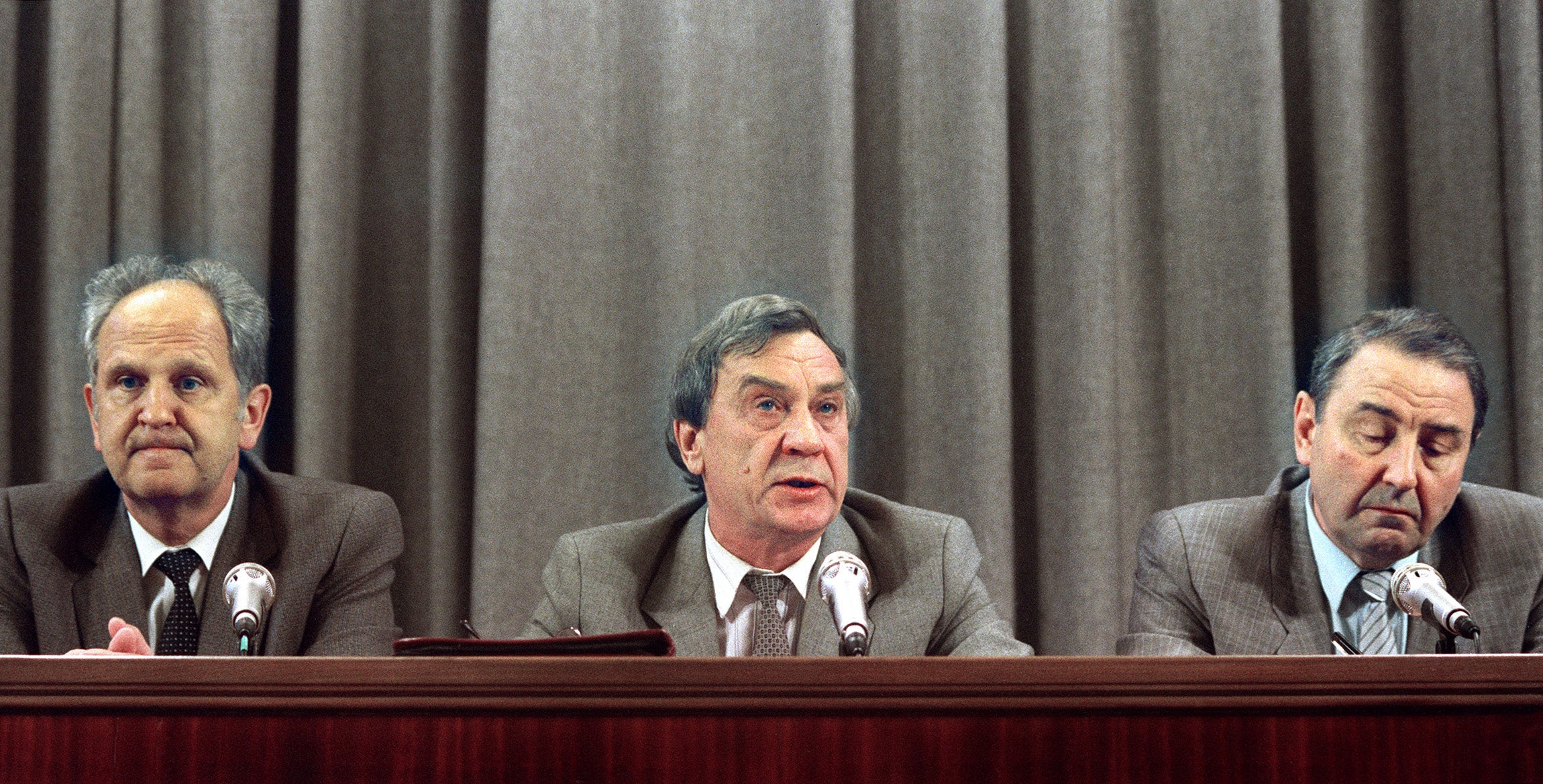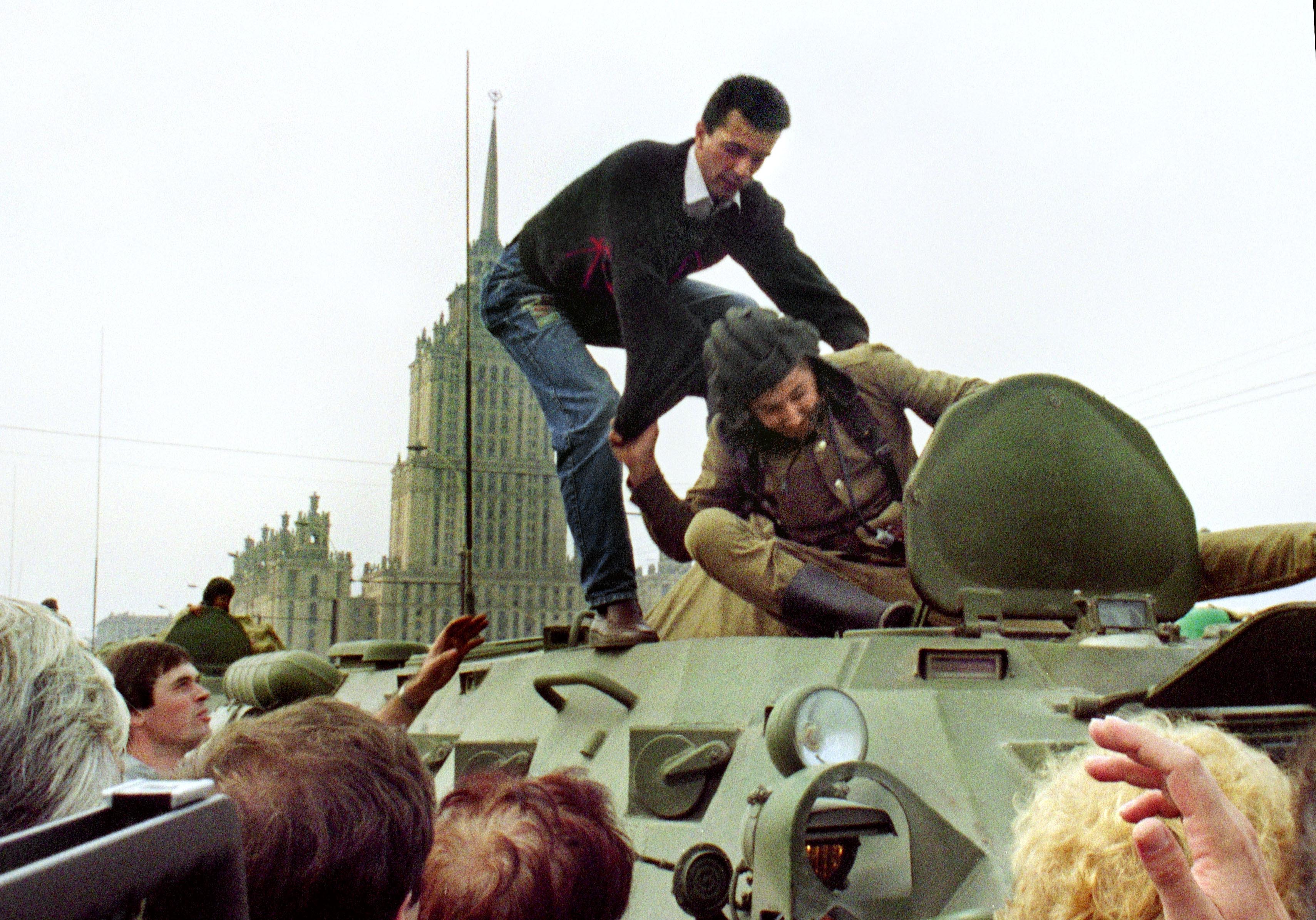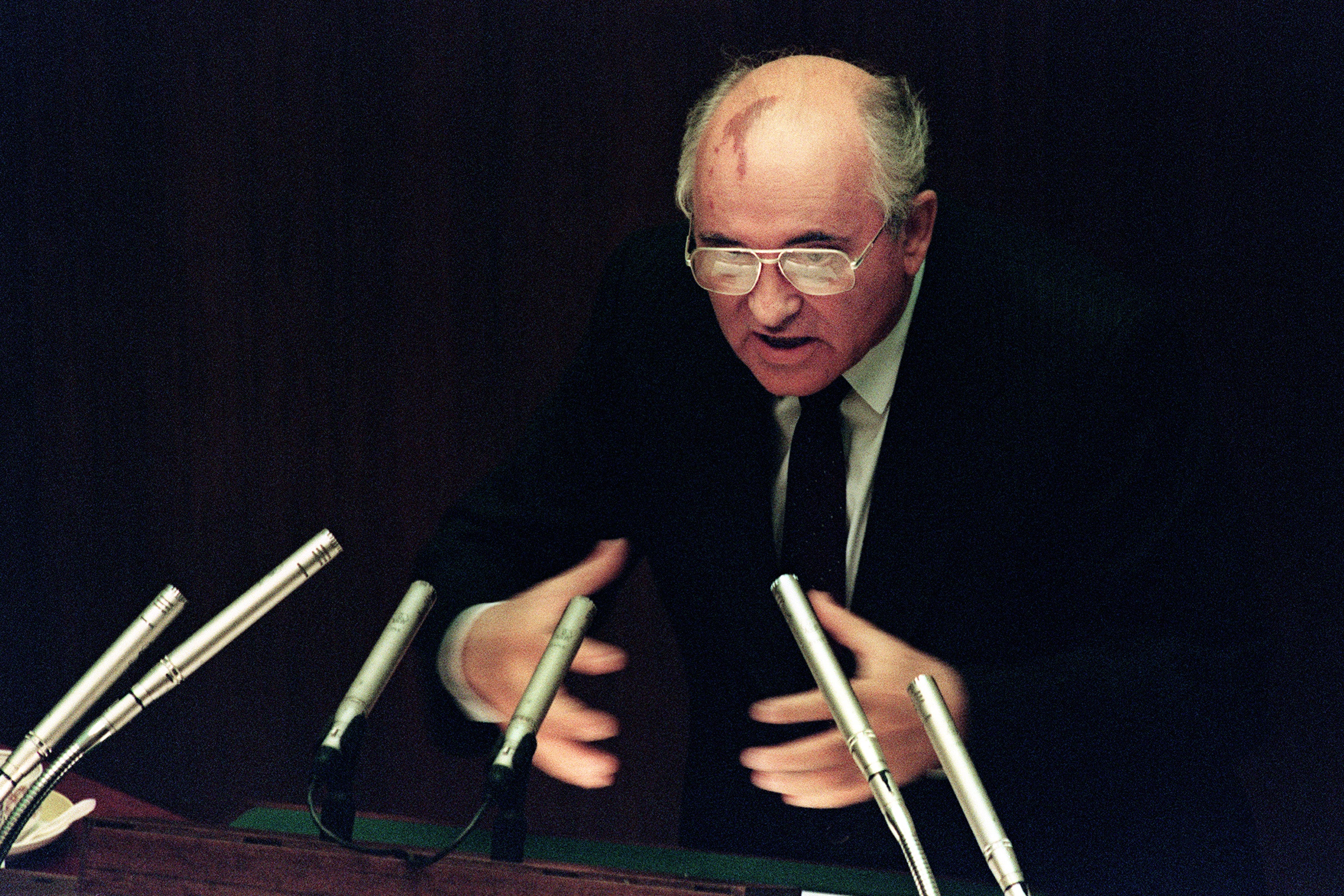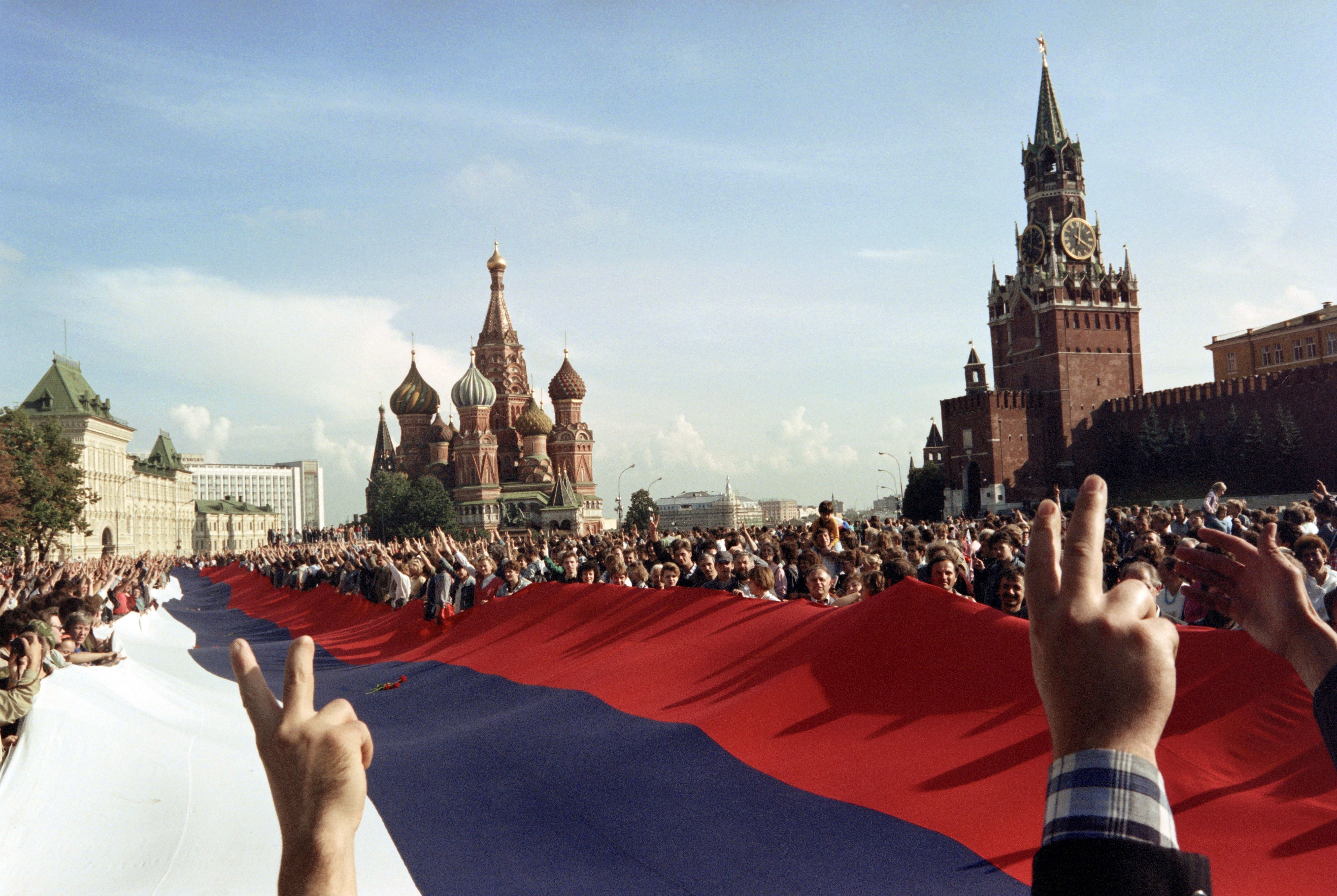Fall of the Soviet Union: Three days that shook Russia and the world
30 years ago this week, a group of drunk and disorganised hardliners attempted to stop Gorbachev’s reformist course – but only succeeded in hastening the Soviet collapse. The consequences of their actions are still keenly felt in Russia today, writes Oliver Carroll in Moscow
Early on the morning of 22 August 1991, an Aeroflot jet carrying Mikhail Gorbachev touched down at Moscow’s Vnukovo airport. The Soviet president, confused following three days of captivity at his Crimean dacha, appeared from the front exit – photographed by the press gaggle in what would become the iconic image of the era. Out of view of the lenses, however, was a second stairway to the rear of the plane. This was from where Vladimir Kryuchkov, ringleader of the “gang of eight” coup leaders, would emerge.
Valentin Stepankov, prosecutor general of Russia, a state yet to formally exist, was waiting at the bottom of the stairs to arrest the KGB chief. He’d typed the warrant himself in the hours before, nervous should his intentions leak, and unsure how he’d be received by a man who still formally controlled elite Soviet special forces. The chief prosecutor had arrived in Vnukovo supported only by a motley band of Ladas, police minivans, and a bus of young recruits he’d scraped together from a loyal police academy.
“I formally introduced myself to Kryuchkov, and asked him to accompany me to a room in the airport,” Stepankov says. “His response was to ask why it wasn’t the Soviet prosecutor doing the arrests.”
The events of the previous three days – when a group of hardliners had attempted to seize control from the reformist Gorbachev, only to see their beloved Soviet Union crash in the process – are among the most studied of all time. But the failure of the attempted coup is also one of history’s greatest enigmas. All along the timeline, from Swan Lake appearing on Soviet TV sets on the morning of 19 August to Gorbachev returning on the 22nd, are a set of improbable combinations, inexplicable non-decisions, and more than a few shots of the strong stuff.
My wife said they looked like something from the Muppet show. I wrote a memo for London later that evening saying the coup looked very wonky indeed
Rodric Braithwaite, UK ambassador to Moscow at the time, knew of the intelligence reports predicting a hardliner plot. But like the Soviet leader himself, he was surprised by its eventual timing. Only weeks earlier, Gorbachev had faced down a call to impose a state of emergency; that, most people thought, had emboldened his authority. “Gorbachev’s off on holiday, and so are we,” Braithwaite recalls telling guests at a lunch on 18 August, before departing for a tour of Russian churches later that evening. When the Braithwaites returned to Moscow in a hurry the very next morning, tanks were already on the streets.
Sandbags stacked at the KGB’s headquarters on Lubyanka Square suggested the putschists had prepared for a fight. But already, from the early hours, it had been clear something was not quite right. At the conspirators’ first attempt to explain their actions in a press conference on 19 August, at least some of them appeared drunk. A young journalist called Tatyana Malkina asked if they understood they had attempted a coup d’etat. Gennady Yanayev, Gorbachev’s recently appointed deputy, who declared himself president following his betrayal, mumbled an answer. But it was his trembling hands that people noticed.

“My wife said they looked like something from the Muppet show,” recalls Ambassador Braithwaite. “I wrote a memo for London later that evening saying the coup looked very wonky indeed.”
Lev Gudkov, then a 44-year-old researcher working in the novel field of opinion polling, found out about the coup in a 7am phone call from his boss, the revered sociologist Yuri Levada. The two men were fearful for what it meant – “We had a sense we were hurtling back to 1918 and the red terror” – but their mood picked up following the unconvincing press conference. By the evening, Levada and Gudkov were broadcasting the results of their first union-wide opinion polls via Echo of Moscow, the one independent radio station that managed to stay on air. “We were able to show a majority opposed the coup in all but two major cities – Minsk and Tbilisi,” Gudkov says. “Minds had shifted.”

With Gorbachev still interned in Crimea, the man on hand to channel popular energy against the plotters was his main democratic rival, Boris Yeltsin. In another inexplicable oversight by the plotters, the outspoken Russian president was never detained – despite an order being written for his arrest. Heavy drinking appears to be at least part of the reason why he was never brought in. By lunchtime, Yeltsin was in the White House, the seat of Russia’s parliament in central Moscow. From here, the lyrical populist would stage his bravest political performance, climbing on top of a tank to declare the plotters’ orders illegal.
Things remained tense and finely balanced into 20 August. On the one hand, most of the Soviet Union’s most capable forces were formally subordinate to coup leaders. On the other, there were growing signs of sabotage and paralysis. As rumours swelled about an anticipated attack on the White House, protesters flocked to central Moscow in tens of thousands. Many of them helped build makeshift barricades from trolleybuses and anything they could lay their hands on. “None of it could have stood up to a tank attack for more than a few seconds, of course,” recalls Braithwaite. “But the atmosphere was exhilarating – something like a music festival, with people playing guitars, sitting around and getting drunk.”
The coup leaders had a detailed scheme to neutralise Yeltsin and the Russian government, with maps and instructions for the use of special forces and so on
In confessions given to chief prosecutor Stepankov, never officially made public, the plotters admitted they had resolved to order the storming of the White House on the night of 20-21 August. “The coup leaders had a detailed scheme to neutralise Yeltsin and the Russian government, with maps and instructions for the use of special forces and so on,” Stepankov says. “A unit from the KGB’s Alfa special forces and Omon special police were supposed to take positions at 1am on the morning of 21 August, and they were due to begin the operation two hours later.”
But the plan was derailed by tragedy. At approximately 11pm, news broke about the deaths of three protesters in an underpass half a mile away from the White House. The men were killed as tanks attempted to break through trolleybus barricades. Dmitry Komar, 23, and Vladimir Usov, 38, were crushed under tank treads. Ilya Krichevsky, 28, was shot in the head. Witnesses said the men believed the tanks were headed for the White House. In reality, the divisions in question had nothing to do with the planned operation, and soldiers appeared to be acting out of fear of falling to the mob.

The deaths had a profound impact on at least one of the gang of eight. Spooked by the reality of deaths on the streets of Moscow, defence minister Dmitry Yazov brought his staff together for talks. He was stunned by what they had to say. Never mind agreeing to a potentially bloody assault on the seat of parliament – with tens of thousands of protesters surrounding it – why was he involved in such a plot in the first place? Realising he could not rely on his generals for support, Yazov gave a command to hold, then withdraw, positions.
“The KGB guys who had gathered at their headquarters at Lubyanka at this point apparently became hysterical,” says Stepankov.
Yazov’s U-turn, and subsequent decision to fly to Crimea later on 21 August to free Gorbachev – with the other gang members traipsing behind him – consigned the coup attempt to history. Yet the three days in August would have long-lasting repercussions not only for the Soviet Union and Mikhail Gorbachev, who were both terminally damaged by the affair, but for Russia itself. On 25 December 1991, following months of humiliation, Gorbachev resigned. The dissolution of the Soviet Union followed a day later.

That cascade of events had the profoundest of impacts on a certain Vladimir Putin, who described it as “the greatest geopolitical catastrophe of the century”. At the time, he was a badged democrat in the team of St Petersburg’s reformist mayor Anatoly Sobchak, and so formally took the opposite side to the putschists. But he appears to have learned a lot from their mistakes. Much of the Kremlin’s domestic policy over the past few years has been driven at limiting the kind of freedom that allowed the Russian people and independent politicians to face down a military coup.
The public’s appraisal of the events of August 1991 has changed over time, battered by the hardships unleashed by Yeltsin’s shaky reforms during the 1990s. Unpublished polls produced by the Levada Centre – Lev Gudkov now heads the research institute that takes his former boss’s name – suggest that support for Yeltsin’s actions has fallen to 10 per cent from a high point of 57 per cent immediately following the aborted coup. Additionally, over half now regret the fall of the Soviet Union.
The fates of the eight men who had fought hard to conserve the Soviet Union are equally complicated. Interior Minister Boris Pugo hanged himself shortly after his arrest. But others played a successful long game. Stalling Stepankov’s investigation for years until public opinion turned against Yeltsin and the market forces he had unleashed, the remaining seven plotters were able to secure an amnesty and escape a trial. The last of them, Oleg Baklanov, died in late July after a successful career in state industry.

To this day Stepankov says he regrets never seeing the men he arrested at Vnukovo airport on trial. It was a “bad precedent” for Russian history and politics, he says. That was laid bare just two years later, when Yeltsin ordered tanks back to the White House to settle a constitutional dispute with his unruly parliament.
“Had there been proper censure, perhaps he wouldn’t have given the order to shoot,” Stepankov says, “and perhaps 150 people wouldn’t have been sent to their graves.”
Join our commenting forum
Join thought-provoking conversations, follow other Independent readers and see their replies
Comments
Bookmark popover
Removed from bookmarks